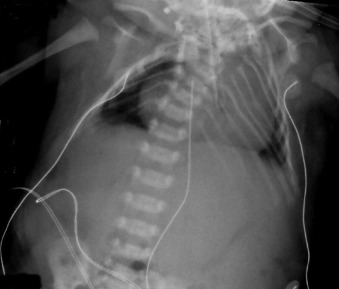Abstract
Spinal malformations associated with vertebral segmentation defects and progressive fusions are seen in numerous disorders, particularly those associated with skeletal disorders. Among spinal malformations, one of the best-described constellation of findings is Klippel-Feil syndrome (KFS). It is a triad of short neck, low posterior hairline, and limitation of head and neck movements. It is caused by the failure of the spine to segment properly during embryonic development. Ultrasound abnormalities include cervical fusions, blocking, and hemivertebrae. These findings should prompt further investigations of the spine, appendicular skeleton, and facies, as well as the neurologic, cardiovascular, and genitourinary systems.
Keywords
Klippel-Feil, vertebrae, VATER
Introduction
Spinal malformations associated with vertebral segmentation defects and progressive fusions are seen in numerous syndromes, particularly those associated with skeletal dysplasias. Among spinal malformations, one of the best-described constellation of findings is Klippel-Feil syndrome (KFS), a triad of short neck, low posterior hairline, and limitation of head and neck movements. The original case report described a patient with significant kyphosis secondary to congenital fusions of multiple level cervical vertebrae, but the term Klippel-Feil now applies to simple synostosis of cervical vertebrae. It can be seen in isolation or with various other skeletal and visceral findings. It has been called Klippel-Feil sequence, Klippel-Feil syndrome, Klippel-Feil abnormality, Klippel-Feil deformity, and Klippel-Feil phenotype, or referred to by descriptive terms ( congenital cervicothoracic vertebrae synostosis, congenital synostosis of cervicothoracic vertebrae syndrome, and many others). Klippel-Feil is a finding, not a diagnosis, as is true of vertebral malformations in general, which are highly associated with other issues. There are other vertebral fusion abnormality syndromes that include progressive synostoses of the vertebrae, including thoracic and lumbar segments, but most of them present beyond the newborn period.
Disorder
Definition
KFS is denoted by various terms; it simply describes the congenital fusion of two or more cervical vertebrae. KFS may be classified by the degree and location of vertebral fusion. Type I is a fusion of cervical and upper thoracic vertebrae with synostoses, type II is an isolated fusion of the cervical spine, and type III shows fusion of cervical vertebrae associated with lower thoracic or upper lumbar fusion. Significant clinical heterogeneity occurs, and KFS can occur in isolation or associated with other skeletal abnormalities; visual and hearing impairment; orofacial anomalies; or visceral anomalies including cardiac, kidney, genitourinary, and neurologic. Some of the syndromes that are often associated with Klippel-Feil abnormalities and malsegmented or fused vertebrae are listed in Table 60.1 .
| Aicardi syndrome |
| Alagille syndrome |
| Caudal dysplasia syndrome |
| CHILD syndrome |
| Chondrodysplasia punctata |
| Diabetic embryopathy |
| Crouzon syndrome |
| Dubowitz syndrome |
| Dysspondylochondromatosis |
| Fanconia anemia |
| Fetal alcohol syndrome |
| Goltz syndrome |
| Gorlin syndrome |
| Holt-Oram syndrome |
| Ischiospinal dysostosis (diaphanospondylodysostosis) |
| Jarcho-Levin syndrome |
| Larsen syndrome |
| Multiple synostosis syndrome |
| Noonan syndrome |
| Robinow syndrome |
| Spondylocarpotarsal syndrome |
| VATER association |
| Wildervanck syndrome |
Prevalence and Epidemiology
KFS is seen in approximately 1 : 40,000 births with a female-to-male predominance of about 3 : 2. The true incidence may be underreported because most patients with congenital abnormalities of the cervical spine appear normal and can be asymptomatic. Congenital fusions are often discovered incidentally later in life on radiographs for scoliosis, neck pain, trauma, decreased range of motion, or neurologic symptoms.
Etiology, Pathophysiology, and Embryology
KFS is a congenital anomaly that is caused by the failure of the spine to segment properly during embryonic development. Congenital fusions can occur at any level of the cervical spine, although 75% occur in the region of the first three cervical vertebrae. The most prevalent fusion is between C2 and C3.
KFS can be isolated or associated with multiple disorders. Inheritance is usually sporadic or autosomal dominant. Mutations have been identified in growth differentiation factor genes ( MEOX1, GDF3, GDF6, NOTCH, and MYO18 ). Chromosomal translocations, deletions, and duplications have also been found in association with KFS. Fetal alcohol exposure and maternal diabetes are important environmental exposures. Fusions in the cervical vertebrae occur in 50% of children with fetal alcohol syndrome.
Manifestations of Disease
Clinical Presentation
KFS describes congenital cervical fusion. The classic clinical triad initially described as Klippel-Feil syndrome includes a shortened neck, a low posterior neckline, and limited neck mobility as demonstrated in a newborn film ( Fig. 60.1 ). Less than half of affected individuals possess all three signs. Associated findings may provide diagnostic clues. Other disorders with progressive vertebral fusions in the postnatal period such as spondylocarpotarsal syndrome and multiple vertebral segmentation defects are illustrated in Figs. 60.2 and 60.3 .











